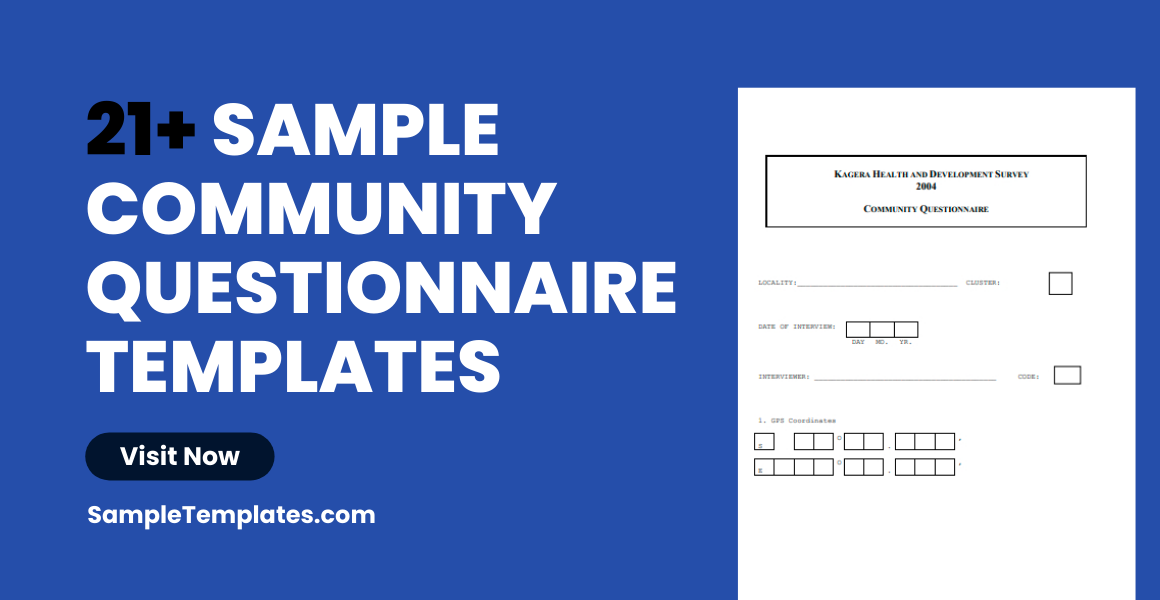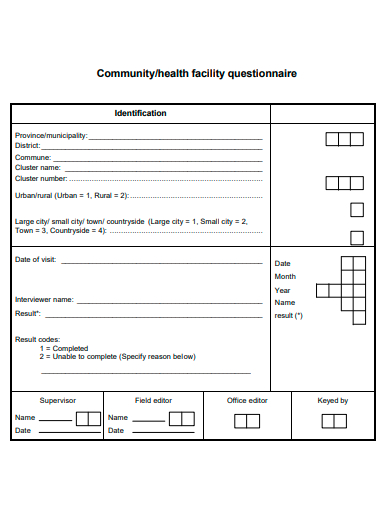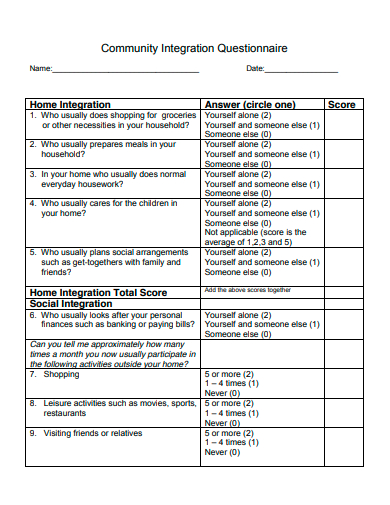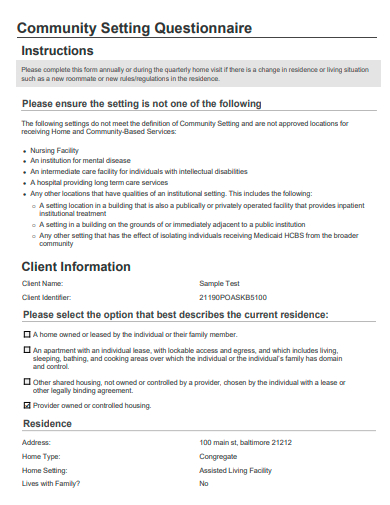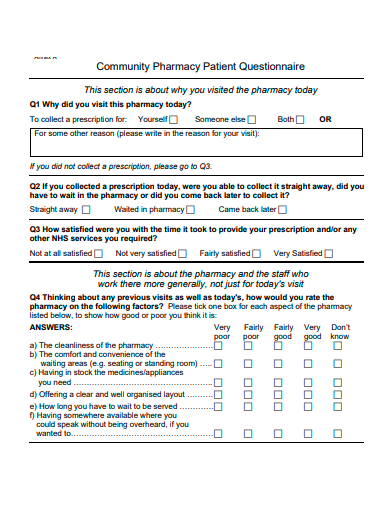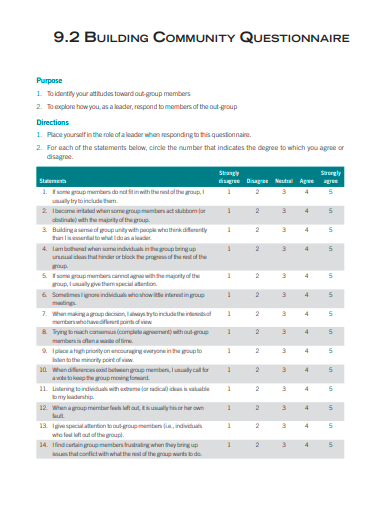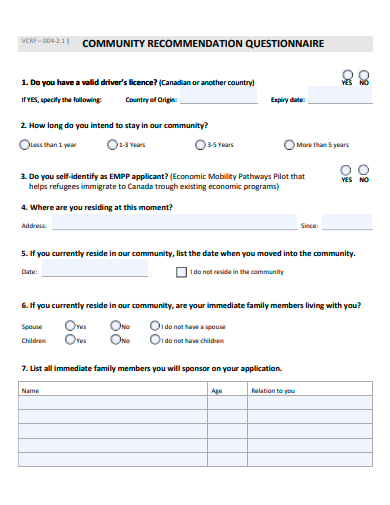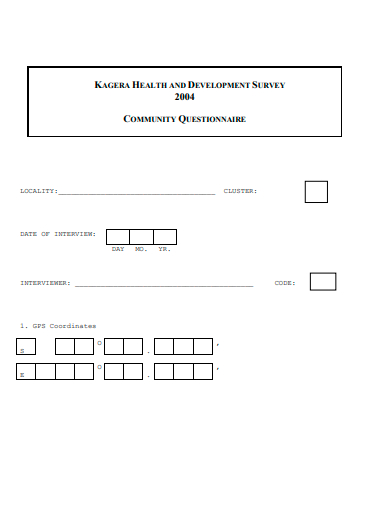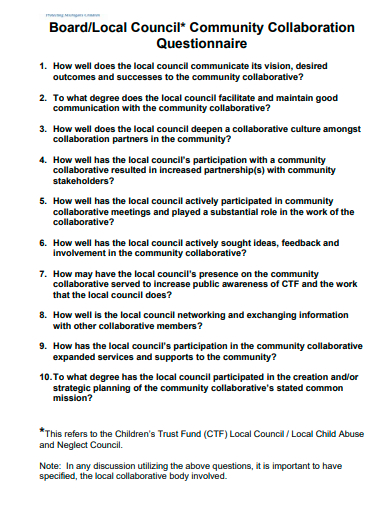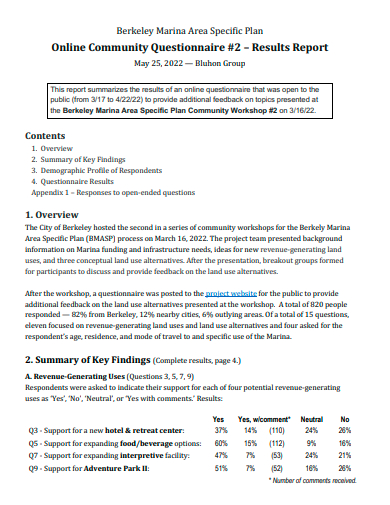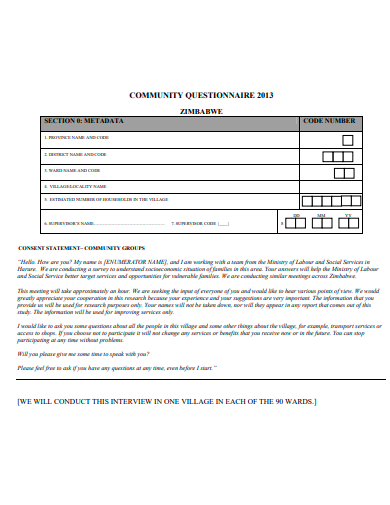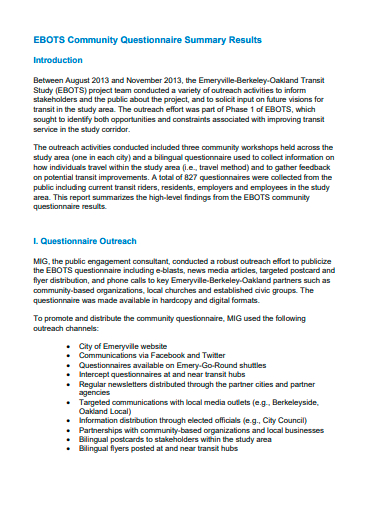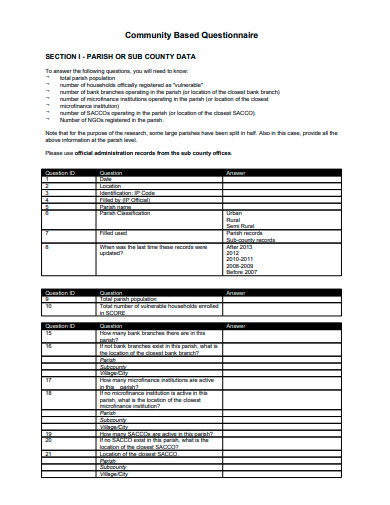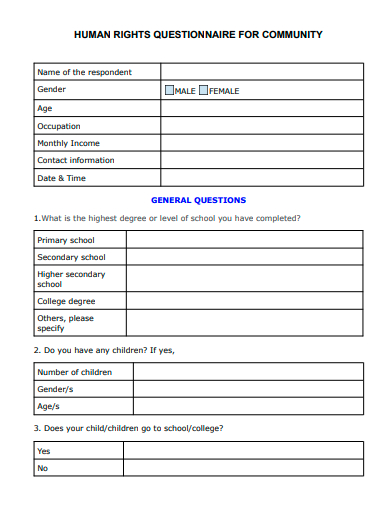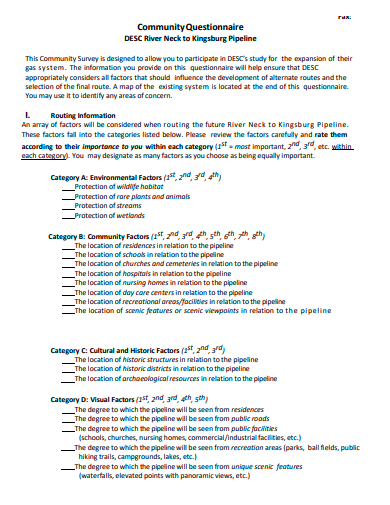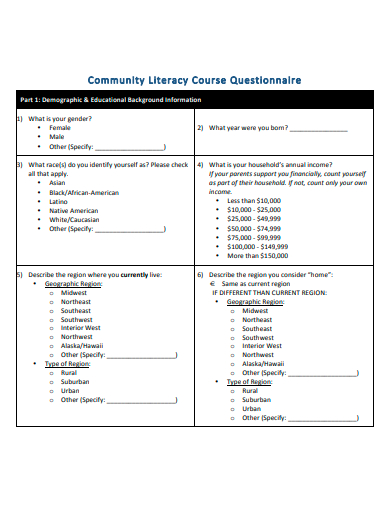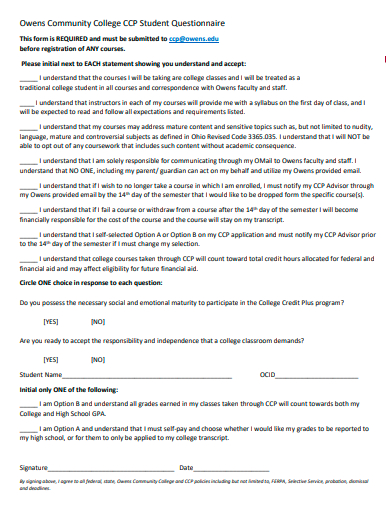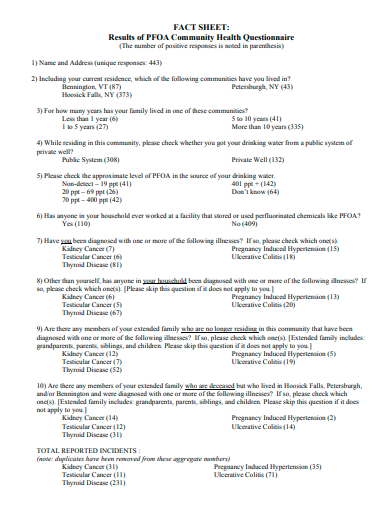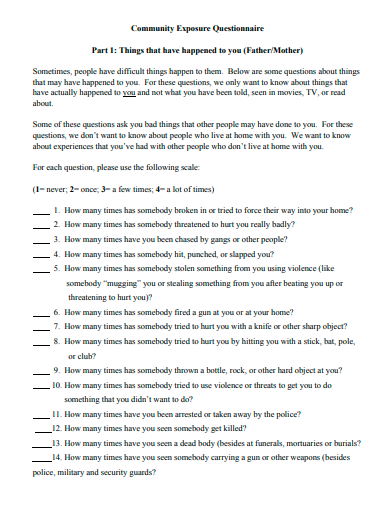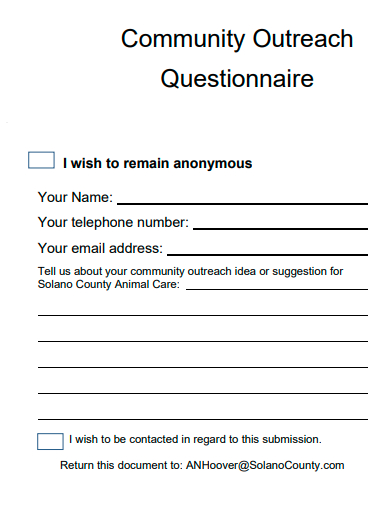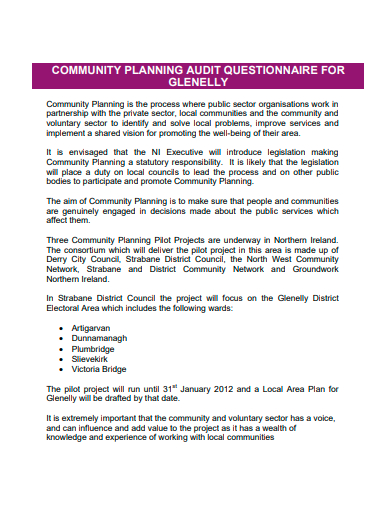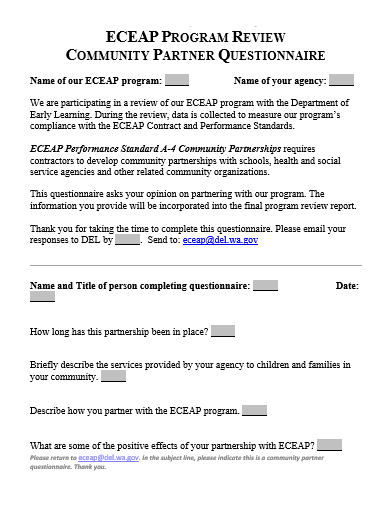Explore the nuances of local sentiment with our Sample Community Questionnaire Template. Designed to harness the diverse opinions of residents, this tool is indispensable for community leaders, organizations, or engaged citizens. It serves as a lens into the very soul of your neighborhood, offering actionable insights. Beyond mere questions, it’s a means to deepen community ties. Whether you’re collecting feedback or orchestrating local events, navigate the process seamlessly with our expertly curated guide.
21+ Community Questionnaire Samples
1. Community Health Facility Questionnaire Template
2. Community Integration Questionnaire Template
3. Community Setting Questionnaire Template
4. Community Pharmacy Patient Questionnaire Template
5. Building Community Questionnaire Template
6. Community Recommendation Questionnaire Template
7. Community Questionnaire Template
8. Community Collaboration Questionnaire Template
9. Online Community Questionnaire Template
What is a Community Questionnaire?
A community questionnaire is a vital instrument that collects data from members of a specific community to garner insights, opinions, feedback, or gather relevant information about them. Whether urban or rural, large or small, every community has its unique dynamics, issues, aspirations, and needs. These questionnaires are crafted to tap into these specifics, bringing them to the surface and making them visible and actionable.
Purpose and Utility
The main goal of a community questionnaire is to understand better and improve the quality of life within a community. They can be used to:
Identify Needs and Concerns: A questionnaire can help pinpoint areas of concern, like safety, sanitation, public services, or health, by directly asking community members about their perceptions and experiences.
Guide Decision-making: Authorities and community leaders can use feedback from these questionnaires to make informed decisions about resource allocation, policy-making, and future planning.
Measure Satisfaction: They can help measure the satisfaction levels of community members regarding various services, facilities, or initiatives in place.
Promote Engagement: By giving community members a chance to voice their opinions, questionnaires can foster a sense of involvement and ownership among residents.
Design and Content
A well-constructed community questionnaire is:
Relevant: Questions are carefully chosen to be pertinent to the specific community and its unique set of circumstances.
Clear: Questions are straightforward, avoiding jargon or complex phrasing.
Objective: It’s essential to avoid leading questions that might influence a respondent’s answer.
Comprehensive: While it’s important not to make the questionnaire too long, it should cover all necessary areas of inquiry.
Typically, a community questionnaire might include:
Demographic Questions: Age, gender, occupation, educational background, etc., to understand the composition of the community.
Opinion-based Questions: These gauge perceptions about various topics, from public services to community programs.
Experience-based Questions: These ask community members about specific experiences, like using a community center or attending a local event.
Open-ended Questions: While they can be harder to analyze, they offer respondents the freedom to express their thoughts and provide qualitative insights.
Implementation and Analysis
The success of a community questionnaire not only depends on its design but also its distribution and subsequent analysis. To be effective:
Ensure Accessibility: The questionnaire should be easily accessible to all members, whether it’s distributed in paper form, through email, or available online.
Promote Participation: Through community meetings, posters, or social media, members should be encouraged and reminded to participate.
Guarantee Anonymity: Respondents are more likely to provide honest answers if they’re assured their responses will be anonymous.
Analyze Thoroughly: Once collected, the data should be methodically analyzed to draw meaningful conclusions and actionable insights.
In essence, a community questionnaire is more than a collection of questions. It’s a potent tool in understanding the pulse of a community, bridging gaps between its members and decision-makers, and fostering an environment of inclusivity and proactive engagement. Properly utilized, it can significantly contribute to the well-being, growth, and harmonious evolution of a community.
10. Sample Community Questionnaire Template
11. Community Questionnaire Summary Results Template
12. Community Based Questionnaire Template
13. Formal Community Questionnaire Template
14. Community Questionnaire in PDF
15. Community Literacy Course Questionnaire Template
Types of Questions used in a Community Questionnaire
Community questionnaires are crucial tools for gauging the sentiments, opinions, and concerns of community members. The effectiveness of such questionnaires hinges on the kind of questions posed. Selecting the right type of question can lead to more accurate, insightful, and actionable data. Here’s a deeper dive into the different types of questions typically used in community questionnaires:
Closed-ended Questions
These questions come with a fixed set of possible answers. Familiar forms include multiple choice, yes/no, or rating scale questions. They’re favorable for their ease of analysis due to standardized answers, making them perfect for collating quantitative data. For instance, asking, “How satisfied are you with the community’s recycling program?” might yield options from “Very satisfied” to “Very dissatisfied.”
Open-ended Questions
Respondents are given the liberty to answer in their own words when faced with open-ended questions. They excel in capturing nuanced feelings and opinions, offering a treasure trove of qualitative insights. An illustrative question could be, “What concerns do you have about the community’s educational facilities?”
Likert Scale Questions
In this format, respondents indicate their level of agreement with a statement, typically ranging from “Strongly Agree” to “Strongly Disagree.” This style is adept at capturing shades of opinions, facilitating a more intricate understanding of sentiments. An example in this category might be, “The community center offers a good range of activities.”
Dichotomous Questions
Offering only two possible answers, such as Yes/No or True/False, dichotomous questions are both direct and easy for respondents. A practical question could be, “Do you use the local library regularly?”
Ranking Questions
Respondents rank options in order of preference or significance when posed with ranking questions. They’re instrumental in deciphering the preferences and priorities of community members. A question might ask participants to “Rank the following community services based on their importance: Public Transportation, Health Services, Educational Facilities, Recreational Centers.”
Semantic Differential Questions
Positioned between two opposite adjectives, semantic differential questions are great for gauging feelings and perceptions. An example might be a prompt like “The community events are,” with a scale spanning “Boring” to “Exciting.”
Demographic Questions
These questions delve into the respondent’s background, gathering details like age, gender, marital status, employment, and educational level. By segmenting data, they provide insights into the diverse subgroups within the community. A typical question might ask, “What is your age group?” with options such as “18-24” or “25-34.”
The choice of question type in a community questionnaire is pivotal and often depends on the survey’s goals. Incorporating a variety of questions ensures the collection of both quantitative and qualitative data, enriching the overall understanding of the community’s perspectives and needs.
16. Community College Student Questionnaire Template
17. Community Health Questionnaire Template
18. Community Exposure Questionnaire Template
19. Community Outreach Questionnaire Template
20. Community Foundations Questionnaire Template
21. Community Planning Audit Questionnaire Template
22. Community Partner Questionnaire Template
How to Write a Community Questionnaire
Creating a community questionnaire is a meticulous process that, when done correctly, can provide invaluable insights into the needs, opinions, and concerns of a community. Creating an effective questionnaire involves more than just jotting down questions; it’s about engaging the community in a meaningful way. Here’s a step-by-step guide to help you create an effective community questionnaire.
Define Clear Objectives
Before drafting any questions, identify the primary goals of your questionnaire. Are you looking to assess the community’s satisfaction with local services? Do you want to understand their preferences for community events? Clear objectives will guide the type and nature of questions you need to ask.
Know Your Audience
Understanding the demographic and cultural nuances of your community is vital. It ensures that the questions are relevant and avoids potential insensitivities. If your community is diverse, consider creating different versions of the questionnaire or adding specific sections that cater to particular groups.
Choose the Right Type of Questions
Different types of questions serve various purposes:
Closed-ended Questions: These are easy to analyze and are suitable for gathering quantitative data.
Open-ended Questions: They provide qualitative insights, allowing respondents to express themselves freely.
Likert Scale and Rating Questions: Gauge the intensity of feelings about a particular topic.
Ensure a mix of these to obtain comprehensive feedback.
Make Questions Clear and Concise
Avoid jargon, complex language, or double-barreled questions that might confuse respondents. For instance, instead of asking, “Do you find the community center’s gym and library adequate?”, separate them into two distinct questions.
Sequence Matters
Start with general, easy-to-answer questions to engage the respondent. Progressively move to more specific or sensitive questions. This sequencing can make the respondent more comfortable and increase the completion rate.
Ensure Anonymity and Confidentiality
Assuring respondents that their answers will remain anonymous and confidential can encourage honest feedback. Make sure to communicate this at the beginning of the questionnaire.
Pilot Test the Questionnaire
Before rolling it out to the entire community, test the questionnaire with a small group. This can help identify ambiguous questions, technical errors, or areas of improvement.
Provide Clear Instructions
Each section should come with clear instructions. If you’re using scales, define them. For instance, if you’re using a scale from 1 to 5, specify whether 1 means “Not at all satisfied” and 5 means “Extremely satisfied.”
Be Mindful of Length
A lengthy questionnaire can deter participation. Aim for a balance where you gather the necessary information without overwhelming the respondent.
Gather and Analyze Responses
Once you’ve collected the responses, analyze the data methodically. Look for trends, patterns, and areas of concern. Tools like spreadsheets or specialized software can help in organizing and interpreting the data.
A well-crafted community questionnaire is an invaluable tool in understanding the pulse of a community. The insights drawn can inform policy-making, resource allocation, and community initiatives, ensuring that the needs and preferences of the community are placed at the forefront.
Related Posts
Sample Business Card Templates
Sample Cashier Job Descriptions
Questionnaire Samples
FREE 10+ Sample HR Resource Templates in PDF
FREE 10+ HR Consulting Business Plan Samples in MS Word | Google Docs | Pages | PDF
FREE 49+ Sample Job Descriptions in PDF | MS Word
FREE 16+ Nonprofit Budget Samples in PDF | MS Word | Excel | Google Docs | Google Sheets | Numbers | Pages
FREE 13+ Academic Calendar Templates in Google Docs | MS Word | Pages | PDF
FREE 10+ How to Create an Executive Summary Samples in Google Docs | MS Word | Pages | PDF
FREE 23+ Sample Event Calendar Templates in PDF | MS Word | Google Docs | Apple Pages
Company Profile Samples
FREE 10+ Leadership Report Samples [ Development, Training, Camp ]
FREE 24+ Sample Payment Schedules in PDF | MS Word
FREE 10+ Return to Work Action Plan Samples in PDF | DOC
Autobiography Samples & Templates
